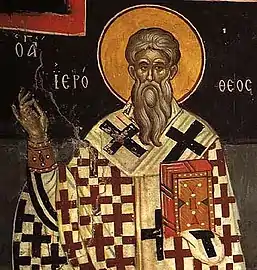Hierotheos the Thesmothete
Hierotheos the Thesmothete (Greek: Ἱερόθεος ὁ Θεσμοθέτης) is the reputed first head and bishop of the Christian Athenians. The title thesmothete means ruler, or junior archon, of Athens (literally "rule-setter").
Hierotheos the Thesmothete | |
|---|---|
 Hierotheos the Thesmothete, by Theophanes the Greek, in Saint Nicholas Anapafsas Monastery, Meteora, Greece | |
| Bishop of Athens | |
| Born | 1st century AD |
| Died | 1st century AD |
| Venerated in | Eastern Orthodox Church Eastern Catholic Churches Armenian Apostolic Church |
| Feast | October 4 |
Biography
Little is known of Hierotheos (Ἰερόθεος "sanctified by God"); church tradition holds that he was one of the learned men in the city of Athens. He was instructed in Christianity by the Apostle Paul, who baptized and ordained him around the year 52 AD. Hierotheos frequently visited and instructed St Dionysius the Areopagite. There is disagreement as to whether Hierotheos was actually a priest or bishop; some traditions describe Dionysius as the first bishop of Athens.[1]
According to Dionysius (On the Divine Names, 3:2), Hierotheos was an accomplished hymnographer:
- "He was wholly transported, wholly outside himself and was so deeply absorbed in communion with the sacred things he celebrated in hymnology, that to all who heard him and saw him and knew him, and yet knew him not, he seemed to be inspired of God, a divine hymnographer."[2]
In more recent years, some have pointed that the name 'Hierotheos' is unique in Greek literature, nor is included in the extremely wide list of proper name known from papyri. The only record of this name is found in a Greek inscription from Athens.[3]
Hierotheos and the Dormition of the Theotokos
Hierotheos stood in the midst of the apostles and comforted them with spiritual songs and hymns which he sang accompanied with musical instruments.[4]
References
-
 Herbermann, Charles, ed. (1913). "Christian Athens". Catholic Encyclopedia. New York: Robert Appleton Company.
Herbermann, Charles, ed. (1913). "Christian Athens". Catholic Encyclopedia. New York: Robert Appleton Company. - Daily Reading, October 4, 2005, The Greek Orthodox Archdiocese of America
- On the problem of Hierotheos' name and the more wide question of the author of the Corpus Dionysiacum, see Mazzucchi, Carlo Maria (2006). "Damascio, autore del Corpus Areopagiticum, e il dialogo ΠEPI ΠOΛITIKHΣ EΠIΣTHMHΣ" [Damascius, author of the Corpus Dionysiacum, and the dialogue ΠΕΡΙ ΠΟΛΙΤΙΚΗΣ ΕΠΙΣΤΗΜΗ]. Aevum (in Italian). 80 (2): 299–334: esp. 324. eISSN 1827-787X. ISSN 0001-9593. JSTOR 20861842 – via JSTOR. Mazzucchi suggests the name of Damascius as the author of the corpus and that Hierotheos was a fictional character, whose name was dragged by an unknown soldier died in 409 BC who was included in a funerary inscription (IG, I, p. 206 n° 454 = IG minor, I, p. 252 n° 957 = IG3, II, p. 782 n° 1191) found in Athens near the Academy. Mazzucchi's theory was welcomed in Reale, Giovanni (2009). "Introduzione. Il Corpus Dionysiacum e i grandi problemi che suscita per la sua interpretazione". In Scazzoso, Piero; Bellini, Enzo (eds.). Dionigi Areopagita. Tutte le opere (in Italian). Milano: Bompiani. pp. 11–29. ISBN 978-88-452-6288-3. This work also includes (pp. 707–762) a reprint of Mazzucchi's article.
-
 Herbermann, Charles, ed. (1913). "Hierotheus". Catholic Encyclopedia. New York: Robert Appleton Company.
Herbermann, Charles, ed. (1913). "Hierotheus". Catholic Encyclopedia. New York: Robert Appleton Company.